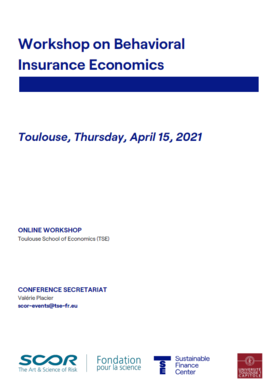
Within the framework of the “Risk Markets and Value Creation” Chair supported by SCOR Foundation for Science, a virtual workshop dedicated to Behavioral Insurance Economics was organised on April 15, 2021, assembling Toulouse School of Economics (TSE) researchers and SCOR Global Life’s Behavioural Science team members. The TSE researchers presented some papers using different methods (e.g., theory, experiments, econometrics) and interdisciplinary research.
Insurance decisions provide fertile ground for identifying the existence and consequences of human behavioral limitations. They invove risk, uncertainty and complexity as well as death-related, long-term and passive decisions.
The session included six speakers covering research in behavioral economics relevant to insurance.
Behavioral Insurance Demand
Findings from studies related to risk and insurance provide some insights regarding insurance preferences. Surveys in risk perception find evidence of over-estimation of low probability risks and under-estimation of high probability risks. Studies on insurance preferences demonstrate more willingness to insure low impact risks than high impact risks. This may be explained by regret as a motivator. Further research is needed into what risks are not insured and why.
Inequality aversion is identified through evidence of lower willingness to insure correlated risks. When an individual will face a risk alone, they are more willing to insure than when others face the same risk. This social comparison may be a reason for a lower willingness to insure low probability high impact risks such as disaster (e.g. flood) which may impact individual and all their peers (neighbours).
Non-performance risk significantly reduces willingness to pay for insurance. If there is even a small chance (1%) the insurance will not pay-out in the event of the risk being realised, willingness to pay is significantly reduced. This over-reaction to non-performance suggests a specific value assigned to peace of mind. Anticipatory utility theory captures the positive impact of waiting for a reward (a holiday booked now for later in the summer) and the negative impact of waiting for a loss (risk of not being able to go on holiday). Willingness to pay to fully avoid a loss (100% certainty of pay-out) may be explained by paying to avoid the worry about this risk in addition to covering the risk. Ambiguity aversion may also have an impact as individuals dislike the uncertainty regarding scenarios when they are and are not covered. The mental load of this worry has a price.
https://knowledge.scor.com/viewprocess/2092
Misperception of Long Term Care risk
The research presented by Phillippe Donder is based on comparing an objective measure of risk using a health microsimulation model called COMPAS and individuals’ subjective view of their risk.
The finding is that misperceptions are significant with some extreme over-estimation and under-estimation. There is a difference in perceptions with respect to longevity and disability. Misperception of risk is part of the reason for under-insurance but closing the gap between perception and risk has only a small impact on demand for insurance. Reducing misperceptions does not dramatically increase demand for LTC insurance.
Further research is being conducted to understand differences in preferences and how demand for LTC changes based on different levels of dependency. The topic of how exposure to the risk could change demand for insurance is an interesting area to develop further. If customers or their family experience the risk event, are they more likely to buy insurance?
https://knowledge.scor.com/viewprocess/2141
Household risk attitudes
Astrid Hopfensitz presented research on "Insurance in the household: individual risk, household risk and intra-household inequality". The paper assesses decisions under risk for couples. Hopfensitz and colleagues have drawn 4 main results of this study:
- Individual risk attitudes are not well explained by individual characteristics (age, finance, marital status) and are uncorrelated within the couple.
- In the symmetric situations (with the same risk for both individuals in the couple), approximately 80% of the couples prefer a reduction of risk at the household level over a reduction of risk at the individual level.
- In the asymmetric situations, when there is inequality between the individual risks, choices are different when the man holds all the individual risk compared to when the woman holds all the individual risk. A lower proportion prioritise a reduction in household risk when only the man would face individual risk in the alternative scenario. This suggests that the couples are averse to the man holding all the risk.
- Married couples put a higher weight on expected utilities from joint household payoff. It could be due to higher intrinsic commitment abilities of these specific couples (better communication and trust) or improved enforcement mechanisms (through family norms or marriage contract).
The question of how households take and share risks has many interests and this experiment design could be leveraged to explore insurance demand. Decision making in the household is relevant to understand insurance demand which is more likely to be a couple or household decision than an individual decision.
https://knowledge.scor.com/viewprocess/2116
Robo-advising for small investors
A field experiment carried out with an employee savings plan with a large French asset manager was presented by Milo Bianchi. The robo-advice option was offered to employees who were already part of the savings plan. The robo collects information on risk appetite, financial knowledge, and savings horizon, then proposes an allocation and if accepted implements it. The robo sends e-mail alerts to propose portfolio re-balancing as appropriate. This study found that take-up was highest among those with smaller portfolios, perhaps that would not have access to human advisor. Those that took up robo-advice were willing to accept big changes to their allocations as proposed by the robo compared to more cautious changes usually proposed by human advisors. Those taking robo advice had a higher number of connections per month – paying more attention to their investments. There was also an increase in trading activities and investment amounts for those who chose robo advice. Those taking robo advice also increased their share in equity investment, increasing the risk profile and returns on their fund.
The study of robo advice is of interest in the insurance space where the online channel has increased significantly since the pandemic. The investment study shows that robo-advice as an alternative to human advice can improve financial inclusion reaching lower income groups. Attitude to robo-advice in this investment study suggests a willingness to follow advice that includes significant changes to existing portfolio. The ongoing connection with robo-advice is also of interest in the insurance space as part of increasing engagement with long term insurance customers to review their needs over time. Academic research in the robo-advice space has been increased since 2017 and further study in this area is continuing to explore what drives trust with an advisor, and the longer-term effects of using the robo-advisor.
https://knowledge.scor.com/viewprocess/2161
Insurance and Portfolio Decisions
Olivier Armantier introduced the Survey of Consumer Expectations (SCE) produced by the Federal Reserve Bank of New York (The Fed). Data has been collected since 2013, in three waves from August-September 2015, August-September 2016, and February 2021. They are currently conducting a fourth survey that began in April 2021. Studies based on these survey results have been conducted to understand insurance demand. The most surprising result is that insurance coverage and risky asset holding are both positively correlated with wealth. While this may not be a surprise for practitioners within the insurance industry, standard theory implies that it should be the poor that would need insurance coverage more and the wealthy would need it less. Further research to understand this puzzle is continuing focused on behavioral concepts. Regret Avoidance might be a plausible explanation based on the idea that the wealthy might feel regret if they incur damages without having enough insurance. Mental Accounting suggests that people have a specific budget in their mind regarding what to invest and what to insure. The money is not fungible across these theoretical budgets, but it does increase with wealth so, the wealthy would feel they have more money within their budgets to spend on investments and insurance. Research to date has focused on auto insurance and homeowner insurance but the concepts have wider applications as this phenomenon also exists for life insurance. These surveys are a rich source of data to provide insights on attitudes and behaviors related to financial decisions.
https://knowledge.scor.com/viewprocess/2158
Decision making under risk
Francesca De Petrillo shared research on risk attitudes of primates that has been carried out to provide insight into the component of human decision-making that is biological as distinct from cultural influences.
Key Takeaways
There is a gap in academic research in behavioral insurance and there is potential to gain insights into how behavior differs from what we might expect under standard economic theory. New concepts were introduced in terms of behavioral concepts that impact attitudes to and demand for insurance. Experimental designs and research approaches presented provide a framework for further exploration of these concepts in the context of life insurance.
SCOR-TSE Workshop Presentations
- Behavioral Insurance Economics: an Introduction | Presentation
- Insurance and Portfolio Decisions - A Wealth Effect Puzzle | Presentation
- State-Dependent Preferences and Probability Misperceptions in Long-Term Care Insurance | Presentation
- How comparative work on human and non-human primates can shed light on humans’ decisions | Presentation
- Insurance in The Household: Individual Risk, Household Risk and Intra-Household Inequality | Presentation
- Robo-Advising for Small Investors | Presentation
